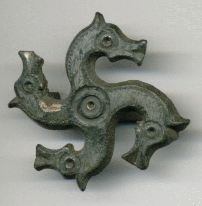


Revised Public Edition, 2005
![]()



Revised Public Edition, 2005
![]()
I authored this article when still a member of the Wolfbund, and it was published within official Wolfbund publications. While they may in fact continue to utilize this article as a tool of instruction, I retain sole authorship and ownership of said article, and it may not be reproduced without my consent or without crediting me as the rightful author. -Hildolf Von Eisenwald
When it was initially requested that I research & compose an article on the Swastika for the internal publication of the Wolfbund, I despaired of finding much beyond what I would term “the usual” information on this symbol; I was pleasantly surprised to find more than a few unexpected facts that you’ll find presented alongside “the usual” here. Although this paper is decidedly “abbreviated” on this subject for the sake of space, clarity, and the occasional gaps fact wise that I wasn’t able to fill in, I would like to encourage others to seek out information on this subject beyond what is presented here (rest assured there is still plenty of it out there) so that deeper and ever more profound understanding regarding this venerable holy sign may be gleaned with each new exploration. Although I present some information here that falls outside the Indo-European family tree, one should bear in mind that history, lore, and practices found within the IE “tree” are most relevant to understanding and applying the Swastika in the cultural matrix that we are mutually focused upon within the Pan-Germanic Heathen Renaissance.
The Swastika has loomed large in the psyche of man from its first appearance in prehistoric cultures, to its current use by various religions and organizations that hold diverse interpretations where this ancient symbol is concerned; despite its “fall from grace” in the western world, this symbol still wields immense influence here, eliciting a broad spectrum of emotions ranging from pride, awe, fear, and hate; this fact in and of itself is a testimony to the latent and enduring power of this symbol, regardless of any value shifts.
The word Swastika itself comes from the Sanskrit "Svastika", which is a compound of "su" meaning "well" and "asti" meaning "Being", literally resulting in a meaning of "Well Being,” and had connotations of good fortune; the ending "ka" was added to distinguish the word from a similarly sounding one. the Swastika is known under various names around the world; among these are: tetraskelion (Greek for "four-leg") hakenkreuz (German for "hook-cross") and fylfot ( an archaic English word for "fill-foot" or "four foot")
While recent history has placed the Swastika clearly in the Germanic “camp” (Scandinavia, Germany, England, etc), this symbol has historically shown up in Turkey among the Hittites, in Greece, India, China, Japan, Western & Eastern Europe, the United States and other places throughout the entire world within various cultures and religions.
Within pre-Christian Russia, the Rus, heathens that they were, had a full compliment of divinities; among these was Swarog, the sun, whose symbol was the "Eternal Fire"; this symbol was represented by the Swastika, which underwent a value shift to a meaning of "God's Greatness" after the introduction of Christianity.
Throughout Europe, the swastika was a common charge on familial, regional, and national heraldry (coats of arms); it continued to be used in heraldry until the end of World War II, when stigma surrounding the symbol prompted its removal. Within Medieval England, the Fylfot was used to fill in the space at the bottom of stained glass windows (hence the term "fill-foot", one of the translations for "fylfot".) A variant of the swastika (an eight-armed double swastika) represented German Vehmic Courts (from Vehme, "punishment") which began in the Middle Ages as civil tribunals.
Some of the earliest known swastikas date from 2500 or 3000 B.C. in India and Central Asia, although there has been at least one swastika found in Mezin (near Kiev) that was painted on a Paleolithic cave under the wings of an image of a flying bird between 10,000-12,000 years ago. The presence of the bird seems to imply a sky/celestial association; the associations of the Swastika with the celestial realms and the sky is by no means restricted to a specific time period or region…the Swastika is often linked to comets, movement of the stars, or to the sun in various locations around the globe. Considering the geographical location of the cave (in the Ukraine), I speculate that the Mezin Swastika could have been painted by an ancient Indo-European.
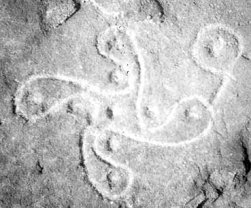
English Iron Age Swastika Stone Carving
In Jainism, the four arms of the Swastika are a reminder that during the cycles of birth and death, a person can be born into one of four destinies: animal beings, heavenly beings, hellish beings, or human beings; the Swastika also serves as a reminder of the fourfold Jain Sangh.
Within Hinduism, the Swastika is associated with the god Ganesha, and is seen as symbolizing the interconnecting point between the mundane and the numinous; the Swastika is also said to represent the yoni (vulva), and the root chakra at the base of the spine which houses the Kundalini (female serpent energy.) Sir George Birdwood writing in Report on the Old Records of the India Office, 1891], says: "The right-handed Swastika is, with the Hindus, the emblem of the god Ganesh; it represents the male principle; it typifies the sun in its daily course from east to west; lastly, it symbolizes light, life and glory. The left-handed Swastika or Sauwastika, on the contrary, is the emblem of the Goddess Kali; it represents the female principle, typifies the course of the Sun in the subterranean world from west to east, and symbolizes darkness, death and destruction." The Swastika is traced prior to any pious religious activity within Hinduism; there are sixteen specific rituals within the life of a Hindu, each of which begins with the Swastika. There is at least one theory presented by a Hindu source that posits that the Swastika may have originated as the blueprint for a fortress, the configuration of which would preserve three fourths of the integrity of the fortification against attack. Etymology possibly corroborates this theory, through examination & combination of the Sanskrit words "su" (meaning "good") and "vastu" (meaning "habitation") yielding the idea of a "good habitation'.
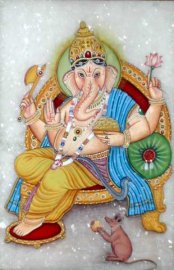
The God Ganesha
Theorized Design of the “Swastika Fort”
Among pre-Christian Northern Europeans, the Swastika was associated with the god Thorr and his hammer Mjöllnir, as well as having solar associations and connections with the "horizontal plane" via its four-fold nature. The Swastika was carved alongside

The Dahmsdorf Spearhead
Runic formulas, into free-standing Rune stones, jewelry, and weapons in order to imbue them with the numinous might of the symbol, possibly with the intent of calling upon the dynamic power of Thorr, the sun, or the of the horizontal plane of manifestation.

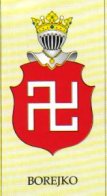
Between the years of 1871 & 1875, German archaeologist Heinrich Schliemann excavated the site of Homer's Troy (Hissarlik) on the shores of the Dardanelles. During this excavation, Schliemann found artifacts with swastikas, which he associated with ones that he had seen near the Oder River in Germany (Schliemann identified those as being directly linked to his own Teutonic heritage.)
| Well into the 1920’s, the Swastika was used quite frequently in the western world, adorning blankets, clothing, appearing on greeting cards, and even being used in marketing campaigns by soft drink companies; interestingly enough, the Swastika still carried with it connotations of good luck well into the beginning of the 20th century. |
 Promotional Coca-Cola “Watch Fob” Swastika |
| In 1921 , Robert Baden-Powell, founder of the Boy Scouts, identified the Swastika as "The Thanks Badge" in his book , What Scouts Can Do: More Yarns, stating "whatever its origin was, the Swastika now stands for the Badge of Fellowship among Scouts all over the world, and when anyone has done a kindness to a Scout it is their privilege to present him—or her—with this token of their gratitude, which makes him a sort of member of the Brotherhood, and entitles him to the help of any other Scout at any time and at any place." The "Thanks Badge" design that included the Swastika in its design was used by the Boy Scouts from 1911 to 1923 |
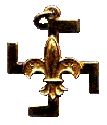 Boy Scouts Badge of Fellowship or “Thanks Badge” |
In 1920, the Swastika was adopted as the official insignia of the German Nazi Party (NSDAP) at the Salzburg Congress. Adolf Hitler provided a description of the party's new flag in his book Mein Kampf: "In red we see the social idea of the movement, in white the nationalistic idea, in the swastika the mission of the struggle for the victory of the Aryan man, and, by the same token, the victory of the idea of creative work, which as such always has been and always will be anti-Semitic." This flag would be seen flying prominently over territories occupied by German forces during World War II until the defeat & surrender of their forces in May of 1945.
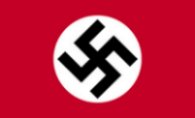
Currently, the Swastika is still being used by a variety of groups with varying interpretations surrounding it.
The Swastika is still actively being used among Hindus worldwide, ideologically free of the current stigma placed upon it by the events and aftermath of the Second World War…this could be due, in great part, to their separation from the western world and its current saturation of negative associations with the Swastika via mass media and sectarian propaganda.
White Power and White Separatist groups worldwide currently use the Swastika and other symbols of European heritage to promote their particular and varied agendas (few of them agree on much) with very little focus on the long-term history and lore that surround these symbols, preferring instead to focus on the imagery associated with only 25 years of the Swastika’s history, the same 25 years of history that resulted in its relegation to a place of infamy in the modern mind.
Various organizations and individuals focused on the rebirth/reestablishment of pre-Christian European ancestral religious traditions have gingerly begun the process of reintegrating the Swastika back into the symbol systems of their beliefs & practices, some attempting to educate others of like mind as well as the general public about the more culturally traditional associations with this symbol. Only time will tell what fruits this effort will yield.
From its earliest appearance on a cave wall to its most current use among various cultures and organizations, there has been one common fact where the Swastika is concerned: that factor is power. Some might ask “Why bother reclaiming a symbol so maligned within the society we live in? Is it really worth the trouble?” My answer would be two-fold. First, we are the Sons and Daughters of Odhinn, and we need not feel obligated to be restricted by the shallow sensibilities of those thinking inside the little boxes that most live within….we are the most capable among our folk to use this symbol properly & responsibly, as we are more aware of its true nature and potential in the context of our deeper heritage. The second part of my answer is this: we should reclaim it because it belongs to us…it is our Birthright.

©Copyright reserved on all written content
![]()